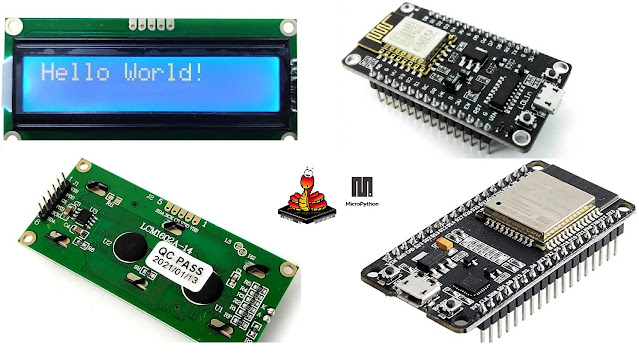Màn hình LCM1602A-14 DS-162-3V3-SPI2C V6 có ưu điểm là có cả 2 giao thức I2C và SPI, đồng thời dùng điện áp 3.3V, phù hợp cho ESP8266 / ESP32 hoặc Pico.
Kết nối VSS -> GND, VDD ->3.3V
ESP8266:sda=12(D6), scl=14(D5)hoặc sda=12(D6), scl=13(D7)
ESP32GPIO21(SDA), GPIO22(SCL)
Bài này, hướng dẫn kết nối màn hình với ESP8266 và ESP32
Bước 1: Tải thư viện về máy và lưu vào ESP8266 / ESP32 với tên LCD_I2C.py
# Use lib for ESP8266 and ESP32 with LCD both I2C and SPI model LCM1602A-14 DS-162-3V3-SPI2C V6
import machine
import utime
COLUMNS = 16
ROWS = 2
#Instruction set
CLEARDISPLAY = 0x01
ENTRYMODESET = 0x04
ENTRYLEFT = 0x02
ENTRYRIGHT = 0x00
ENTRYSHIFTINCREMENT = 0x01
ENTRYSHIFTDECREMENT = 0x00
DISPLAYCONTROL = 0x08
DISPLAYON = 0x04
DISPLAYOFF = 0x00
CURSORON = 0x02
CURSOROFF = 0x00
BLINKON = 0x01
BLINKOFF = 0x00
FUNCTIONSET = 0x20
_5x10DOTS = 0x04
_5x8DOTS = 0x00
_1LINE = 0x00
_2LINE = 0x08
_8BITMODE = 0x10
_4BITMODE = 0x00
class LCD:
def __init__(self, sda, scl):
self.column = 0
self.row = 0
self.address = 62 #0x3e
self.command = bytearray(2)
_sda = machine.Pin(sda)
_scl = machine.Pin(scl)
if (sda==12 and scl==13) or (sda==12 and scl==14) :
self.i2c=machine.I2C(sda=_sda, scl=_scl, freq=400000)
else:
self.i2c=machine.SoftI2C(sda=_sda, scl=_scl, freq=400000)
utime.sleep_ms(50)
for i in range(3):
self._command(FUNCTIONSET | _2LINE )
utime.sleep_ms(10)
self.on()
self.clear()
self._command(ENTRYMODESET | ENTRYLEFT | ENTRYSHIFTDECREMENT)
self.set_cursor(0, 0)
def on(self, cursor=False, blink=False):
if cursor == False and blink == False:
self._command(DISPLAYCONTROL | DISPLAYON | CURSOROFF | BLINKOFF)
elif cursor == False and blink == True:
self._command(DISPLAYCONTROL | DISPLAYON | CURSOROFF | BLINKON)
elif cursor == True and blink == False:
self._command(DISPLAYCONTROL | DISPLAYON | CURSORON | BLINKOFF)
elif cursor == True and blink == True:
self._command(DISPLAYCONTROL | DISPLAYON | CURSORON | BLINKON)
def off(self):
self._command(DISPLAYCONTROL | DISPLAYOFF | CURSOROFF | BLINKOFF)
def clear(self):
self._command(CLEARDISPLAY)
self.set_cursor(0, 0)
def set_cursor(self, column, row):
column = column % COLUMNS
row = row % ROWS
if row == 0:
command = column | 0x80
else:
command = column | 0xC0
self.row = row
self.column = column
self._command(command)
def write(self, s):
for i in range(len(s)):
utime.sleep_ms(10)
self.i2c.writeto(self.address, b'\x40'+s[i])
self.column = self.column + 1
if self.column >= COLUMNS:
self.set_cursor(0, self.row+1)
def _command(self, value):
self.command[0] = 0x80
self.command[1] = value
self.i2c.writeto(self.address, self.command)
utime.sleep_ms(1)
Bước 2: Tải file Code này về và test thử
# /*******************************************************************************
# * Sử dụng màn hình LCD loại LCM1602A-14 DS-162-3V3-SPI2C V6 (adress: 0x3e = 62)có cả giao thức I2C và SPI Trên ESP8266
# ********************************************************************************
# * Connect ESP8266:
# * option1: sda=12(D6), scl=14(D5)
# * option2: sda=12(D6), scl=13(D7)
# *
# * Connect ESP32
# * The ESP32 has two I2C channels and any pin can be set as SDA or SCL. When using the ESP32 with the Arduino IDE, the default I2C pins are
# * GPIO21(SDA), GPIO22(SCL)
# *******************************************************************************/
from LCD_I2C import * #import LCD_I2C library
from machine import Pin
from time import sleep
led2 = Pin(2, Pin.OUT);
#ESP8266
lcd = LCD(sda=12, scl=14)
#ESP32
#lcd = LCD(sda=21, scl=22)
lcd.set_cursor(0,0) # Set the cursor at first column, first row
lcd.write("Hello World") # Write string to the LCD
sleep(1) # Delay for 1 second
lcd.off() # Off the lcd display without clearing the data
sleep(1)
lcd.on() # On LCD display without cursor and blink - cursor=False, blink=False - by default
sleep(1)
lcd.clear()
lcd.on(cursor=False, blink=True) # On LCD display without cursor and with blink
lcd.write("Without cursor and with blink")
sleep(3)
lcd.clear()
lcd.on(cursor=True, blink=False) # On LCD display with cursor and without blink
lcd.write("With cursor and without blink")
sleep(3)
lcd.clear()
lcd.on(cursor=True, blink=True) # On LCD display with cursor and with blink
lcd.write("With cursor and blink")
sleep(3)
lcd.on(cursor = False, blink = False)
lcd.clear()
lcd.set_cursor(0,0)
lcd.write("Temp:")
lcd.write("30")
lcd.set_cursor(0,1)
lcd.write("RH:")
lcd.write("89%")
sleep(3)
lcd.clear() # Clear the data in display
i = 0
while True:
while (i < 20):
lcd.set_cursor(6,0) #Colum 6 and rows first
lcd.write(str(i*1000))
utime.sleep(0.1)
i = i + 1
lcd.clear()
if (led2.value()==0):
led2.value(1)
lcd.clear()
lcd.write("Led is: OFF")
print("Led is: OFF")
else:
led2.value(0)
lcd.clear()
lcd.write("Led is: ON ")
print("Led is: ON")
sleep(1)

